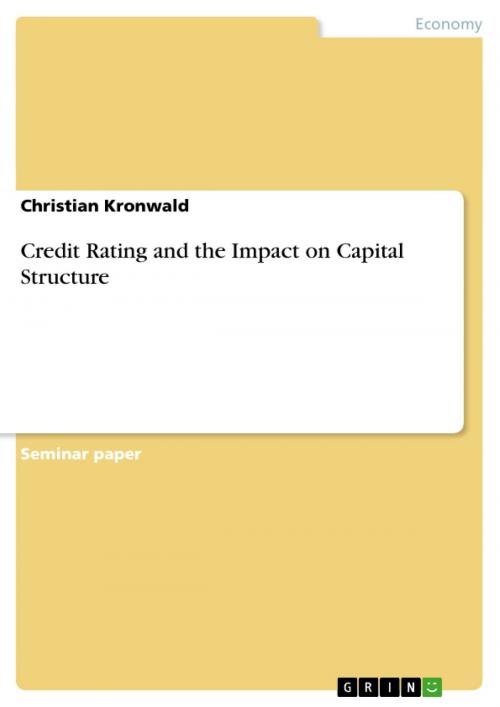Credit Rating and the Impact on Capital Structure
Business & Finance, Finance & Investing, Banks & Banking| Author: | Christian Kronwald | ISBN: | 9783640575572 |
| Publisher: | GRIN Verlag | Publication: | March 25, 2010 |
| Imprint: | GRIN Verlag | Language: | English |
| Author: | Christian Kronwald |
| ISBN: | 9783640575572 |
| Publisher: | GRIN Verlag |
| Publication: | March 25, 2010 |
| Imprint: | GRIN Verlag |
| Language: | English |
Seminar paper from the year 2009 in the subject Business economics - Banking, Stock Exchanges, Insurance, Accounting, grade: 1,3, University of Hohenheim (Lehrstuhl für Bankwirtschaft und Finanzdienstleistungen), language: English, abstract: The question about capital structure is one of the most important issues which the management of a company faces in implementing their daily business. Therefore, the question of which factors affect capital structure decisions attracts high attention in the past and recent literature on capital structure. There are many papers providing valuable insights into capital structure choices, starting with the paper of Modigliani and Miller (1958). The MM-Theorem is generally considered a purely theoretical result since it ignores important factors in the capital structure decision like bank-ruptcy costs, taxes, agency costs and information asymmetry. Based on this paper many other theories which consider factors neglected by Modigliani and Miller have been evolved. Two major theories are the Tradeoff- and the Pecking-Order-Theory. The former loosens assumptions stated in the MM-Theorem by including bankruptcy costs and taxes while the latter introduces information asymmetry into the capital structure discussion. Chapter 2.1 will give a brief overview of these theories. For complexity reasons these models cannot capture all relevant factors affecting the capital structure policy of a company. However, all these theories disregard one cru-cial factor which plays an important role on capital markets all over the world. The significance of Credit Ratings is gradually increasing, and it is doing so in many re-spects. This paper focuses on the Credit Rating-Capital Structure-Hypotheses (CRCS) developed by Darren J. Kisgen as a modern approach to the capital structure discussion. The hypothesis argues that credit ratings have an impact on capital struc-ture decisions due to discrete costs (benefits) associated with a rating change. Firstly, reasons why credit ratings are material for capital structure decisions will be out-lined. Then, situations in which credit rating effects play a role will be examined. For this issue it is very important to show how it can be measured whether a firm is con-cerned about a rating change or not. Afterwards the CR-CS will be empirically tested. The traditional theories don't explain the results obtained in these tests. Therefore credit rating effects will be combined with factors discussed in the Tradeoff- and Pecking-Order-Theory. In subsequent empirical tests credit rating factors will be integrated into previous capital structure test to show that the results of the CR-CS tests remain statistically significant...
Seminar paper from the year 2009 in the subject Business economics - Banking, Stock Exchanges, Insurance, Accounting, grade: 1,3, University of Hohenheim (Lehrstuhl für Bankwirtschaft und Finanzdienstleistungen), language: English, abstract: The question about capital structure is one of the most important issues which the management of a company faces in implementing their daily business. Therefore, the question of which factors affect capital structure decisions attracts high attention in the past and recent literature on capital structure. There are many papers providing valuable insights into capital structure choices, starting with the paper of Modigliani and Miller (1958). The MM-Theorem is generally considered a purely theoretical result since it ignores important factors in the capital structure decision like bank-ruptcy costs, taxes, agency costs and information asymmetry. Based on this paper many other theories which consider factors neglected by Modigliani and Miller have been evolved. Two major theories are the Tradeoff- and the Pecking-Order-Theory. The former loosens assumptions stated in the MM-Theorem by including bankruptcy costs and taxes while the latter introduces information asymmetry into the capital structure discussion. Chapter 2.1 will give a brief overview of these theories. For complexity reasons these models cannot capture all relevant factors affecting the capital structure policy of a company. However, all these theories disregard one cru-cial factor which plays an important role on capital markets all over the world. The significance of Credit Ratings is gradually increasing, and it is doing so in many re-spects. This paper focuses on the Credit Rating-Capital Structure-Hypotheses (CRCS) developed by Darren J. Kisgen as a modern approach to the capital structure discussion. The hypothesis argues that credit ratings have an impact on capital struc-ture decisions due to discrete costs (benefits) associated with a rating change. Firstly, reasons why credit ratings are material for capital structure decisions will be out-lined. Then, situations in which credit rating effects play a role will be examined. For this issue it is very important to show how it can be measured whether a firm is con-cerned about a rating change or not. Afterwards the CR-CS will be empirically tested. The traditional theories don't explain the results obtained in these tests. Therefore credit rating effects will be combined with factors discussed in the Tradeoff- and Pecking-Order-Theory. In subsequent empirical tests credit rating factors will be integrated into previous capital structure test to show that the results of the CR-CS tests remain statistically significant...















